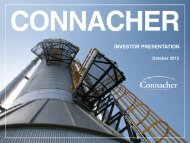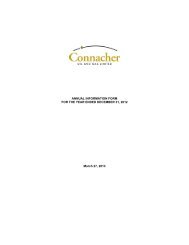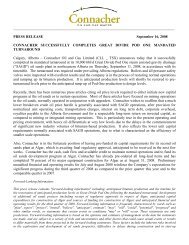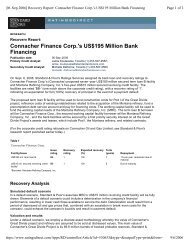ANNUAL REPORT 2011 - Connacher Oil and Gas
ANNUAL REPORT 2011 - Connacher Oil and Gas
ANNUAL REPORT 2011 - Connacher Oil and Gas
Create successful ePaper yourself
Turn your PDF publications into a flip-book with our unique Google optimized e-Paper software.
AR <strong>2011</strong><br />
PG 52<br />
3.2 Inventories<br />
Inventories are stated at the lower of cost or net realizable value. Cost comprises direct purchase <strong>and</strong> blending costs, costs of production <strong>and</strong> other<br />
indirect costs <strong>and</strong> is determined using the weighted average cost method. Net realizable value is the estimated selling price in the ordinary course of<br />
business less costs to complete <strong>and</strong> sell.<br />
3.3 Exploration <strong>and</strong> Evaluation assets (“E&E”)<br />
E&E expenditures incurred prior to acquiring the legal right to explore are charged to expense as incurred <strong>and</strong> recorded as E&E expense in net<br />
earnings (loss).<br />
All costs directly associated with exploration <strong>and</strong> evaluation of oil <strong>and</strong> gas activities are initially capitalized. E&E costs are those expenditures where<br />
technical feasibility <strong>and</strong> commercial viability has not been yet been determined <strong>and</strong> include license <strong>and</strong> unproved property acquisition costs, geological<br />
<strong>and</strong> geophysical costs <strong>and</strong> costs of drilling exploratory wells.<br />
E&E costs are not amortized except for the costs associated with unproved l<strong>and</strong> which are amortized to expense over the lease term. E&E assets are<br />
transferred to property, plant <strong>and</strong> equipment when they are determined to meet technical feasibility <strong>and</strong> commercial viability.<br />
The carrying amount of E&E assets is tested for impairment in accordance with note 3.6 annually, upon transfer to property, plant <strong>and</strong> equipment,<br />
when an area is determined not to be technically feasible <strong>and</strong> commercially viable or the company decides not to continue with its activity.<br />
3.4 Property, plant <strong>and</strong> equipment (“PP&E”)<br />
Recognition <strong>and</strong> measurement<br />
Property, plant <strong>and</strong> equipment is initially recognized at cost which represents all costs directly associated with the development of petroleum <strong>and</strong><br />
natural gas reserves where technical feasibility <strong>and</strong> commercial viability have been determined. Such costs include drilling costs of development wells,<br />
tangible costs of facilities <strong>and</strong> infrastructure construction, costs of optimization <strong>and</strong> enhanced recovery projects, proved property acquisition costs,<br />
asset decommissioning costs, transfers from E&E assets <strong>and</strong> borrowing costs relating to qualifying assets.<br />
Expenditures on major maintenance repairs comprise the cost of replacement assets or parts of assets, inspection costs <strong>and</strong> overhaul costs. Where<br />
an asset or part of an asset that was separately depreciated is replaced <strong>and</strong> it is probable that future economic benefits associated with the item<br />
will flow to the company, the expenditure is capitalized <strong>and</strong> the carrying amount of the replaced asset is derecognized. Major inspection <strong>and</strong> overhaul<br />
costs associated with major maintenance programs are capitalized <strong>and</strong> amortized over the period to the next inspection. Normal overhaul <strong>and</strong> repair<br />
<strong>and</strong> maintenance costs are charged to net earnings (loss) when incurred.<br />
Property, plant <strong>and</strong> equipment are subsequently carried at cost less accumulated depletion, depreciation, amortization <strong>and</strong> impairment. Gains <strong>and</strong> losses<br />
on disposals are determined by comparing disposal proceeds with the carrying amounts of assets sold <strong>and</strong> are recognized in net earnings (loss).<br />
Depletion, depreciation, amortization <strong>and</strong> impairment<br />
Property, plant <strong>and</strong> equipment relating to petroleum <strong>and</strong> natural gas properties including related facilities are depleted <strong>and</strong> depreciated using the unit–<br />
of–production method over the proved <strong>and</strong> probable reserves before royalties <strong>and</strong> determined using forecast prices <strong>and</strong> costs. For the purpose of this<br />
calculation, natural gas is converted to oil on an energy equivalent basis. Estimated future costs to develop proved <strong>and</strong> probable reserves are included<br />
in costs subject to depletion. Costs of major development projects are excluded from depletion <strong>and</strong> depreciation until the asset is available for use.<br />
Property, plant <strong>and</strong> equipment relating to refining properties are depreciated <strong>and</strong> amortized using the straight–line method, based on the estimated<br />
useful lives of assets which range from 3 to 16 years.<br />
Property, plant <strong>and</strong> equipment relating to the corporate office include leasehold improvements <strong>and</strong> computer <strong>and</strong> office equipment. Leasehold<br />
improvements are amortized using the straight–line method over the lease term whereas computer <strong>and</strong> office equipment are amortized using the<br />
declining balance method at 20% to 30% per annum.<br />
The estimates of useful lives of property, plant <strong>and</strong> equipment are reviewed annually <strong>and</strong> if, necessary, changes are accounted for prospectively.<br />
Impairment<br />
The carrying amount of property, plant <strong>and</strong> equipment is reviewed for impairment, in accordance with note 3.6, whenever events or changes in<br />
circumstances indicate the carrying amount may not be recoverable.<br />
3.5 Business combinations <strong>and</strong> goodwill<br />
Business combinations are accounted for using the acquisition method. The acquired identifiable net assets are measured at their fair value at the<br />
date of acquisition. Any excess of the purchase price over the fair value of the net assets acquired is recognized as goodwill. Any deficiency of the<br />
purchase price below the fair value of the net assets acquired is recorded as a gain in net earnings (loss). Associated transaction costs are expensed<br />
when incurred.












